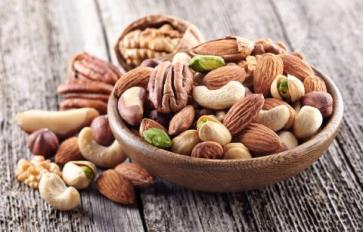
Basically, mustard greens (sarson or rai, as they are called in India) have a superb nutrition-to-calorie ratio—which means you get the most nutrition out of a bite and don’t stack those calories either! Plus, their flavor is such that they can be made into many versatile dishes, and the taste tends to grow on you. But let’s talk about the health aspects first…
Health Benefits of Mustard Greens
Nutritionally speaking, one cup of cooked mustard greens (minus the added oil or salt) is just 21 calories—which is pretty nice if you are on the weight loss bandwagon. It has 0g of fat and just 3g carbs as well. It also has 3g dietary fiber and protein. But when we talk about DRV (daily requirement values) of vitamins and minerals, it proves to be a powerhouse! It has 524% vitamin K, 177% vitamin A, 59% vitamin C, 26% folate, and 19% manganese. On the lower side, it still has another 10% calcium, 8% vitamin E and potassium as well as 7% vitamin B6 and 6% each of phosphorus and copper.
Antioxidants Fight Cancer
Like all richly colored, green leafy vegetables, mustard greens are bursting with antioxidants that not just work to keep you youthful on the outside, but far more importantly, keep your insides working in more youthful environments. So the high level of antioxidants in mustard greens means that eating the greens will help your organs retain their youth that much longer and protect you from all the nasties like heart disease, diabetes, and cancer. The science is simple: the oxygen we breathe lets loose free radicals (negatively charged electrons) in our body where they bounce around, harm cells and cause inflammation. This inflammation ages us and also causes various age-related diseases. So, by reducing this inflammation, antioxidants work towards protecting healthy cells throughout the digestive, respiratory, cardiovascular and nervous system.
Fiber Helps Digestion
Mustard greens are also rich in fiber, which doesn’t simply keep your digestive track in optimum working condition, but also soaks up cholesterol like a sponge. Plus, they help in a process known as bile-binding—where they bind with the bile acids produced in the liver and work together to mop up the extra fat in our system, thus not only helping ease the cholesterol levels but also not letting the bile go awry and cause any further cancers!
Chlorophyll Detoxifies
Mustard greens are green, ergo they are high in chlorophyll—a phytochemical that soaks up toxins from the blood. And by toxins, we don’t just mean alcohol and such but also heavy metals, pesticides and other polluting chemicals that don’t really belong in your body. Thus, eating mustard greens gives your blood and liver thorough detoxification. Studies also indicate that chlorophyll may help in cancer prevention.
Vitamin K Boosts Blood & Bones
The very, very high vitamin K content of mustard greens helps keep your bones as strong as possible by bone mineralization. It also helps in blood clotting and even works toward removing calcium from where it does not belong (think kidney stones). The blood clotting also works internally and helps heal bruises much faster, plus reduces those pesky PMS symptoms.
Vitamin C Builds Better Bones, Teeth, & Skin
Mustard greens are high in vitamin C as well, and vitamin C is one of the best-known antioxidants there is. It builds strong teeth and bones, prevents cell inflammation and damage, and boosts your immune system. It also builds collagen and aids in proper blood circulation, leading you to have better skin.
Vitamin A Improves Vision & Skin
The rich vitamin A content of mustard greens also helps with healthier vision, better skin, and improved neurological functions.
Preparing Mustard Greens
Scientifically known as the Brassica juncea, the mustard plant has many species with the seeds ranging in colors and size. Traditionally, the crops were harvested for the seeds which produce the much popular mustard oil. Popular first in Asia and Russia, the US is now one big grower of mustard as well and the greens have become more and more popular in world recipes too. The leaves and the soft, crunchy stems can both be eaten, and there’s a lot you can do with these pungent greens…Remember though, eating too much of a good thing can be bad as well, so eat them 2-3 times a week, no more. Also, eating too much mustard greens may be a concern if you are on blood thinners since the vitamin K clots blood.
- When shopping for mustard greens or even plucking them from your kitchen garden, look for fresh mustard greens that have crispy and dark green leaves. Avoid leaves that are spotted, discolored or yellow. Because mustard greens are winter crops, they will taste the best from November to March.
- They wilt pretty fast so cook them quickly, or wrap them in plastic wrap and store in the vegetable tray for a day or two.
- Since they are leaves, they need to be washed thoroughly to rid them of any dirt and grime, and if the produce is not organic, chemicals and pesticides need to be rinsed off too. Run them under clean water and then dip them in a bowl of potable water before using as well.
- To cook mustard greens, you can choose to add them to a robust chicken or free-range beef stir-fry. Steaming is also a good option with a bit of butter, garlic, and maybe some pork fat. These greens are acidic, so you can team them with milder greens like spinach, or add some ham to a stir fry as well. You can also add a bit of lemon juice at the end to tone down the pungency of these greens.
- You can also make a traditional Indian pureed curry, or sarson ka saag. Steam together equal amounts of mustard greens, spinach, and radish leaves, along with a chopped onion and tomato. Use just enough water to soak the bottom of the pan and salt to taste. Once steamed (10-15 minutes), puree the lot. In a pan, heat 3 tablespoons olive oil or ghee and add some mustard seeds. Once they pop, add in the green puree and temper with your kind of spices—cumin powder, garam masala, curry powder, paprika, or just a dash of lemon juice. Serve hot with naan, roti or steamed rice.
Have your mustard greens as you like—just remember to source your produce as naturally, organically, fresh, and ethically as possible.








